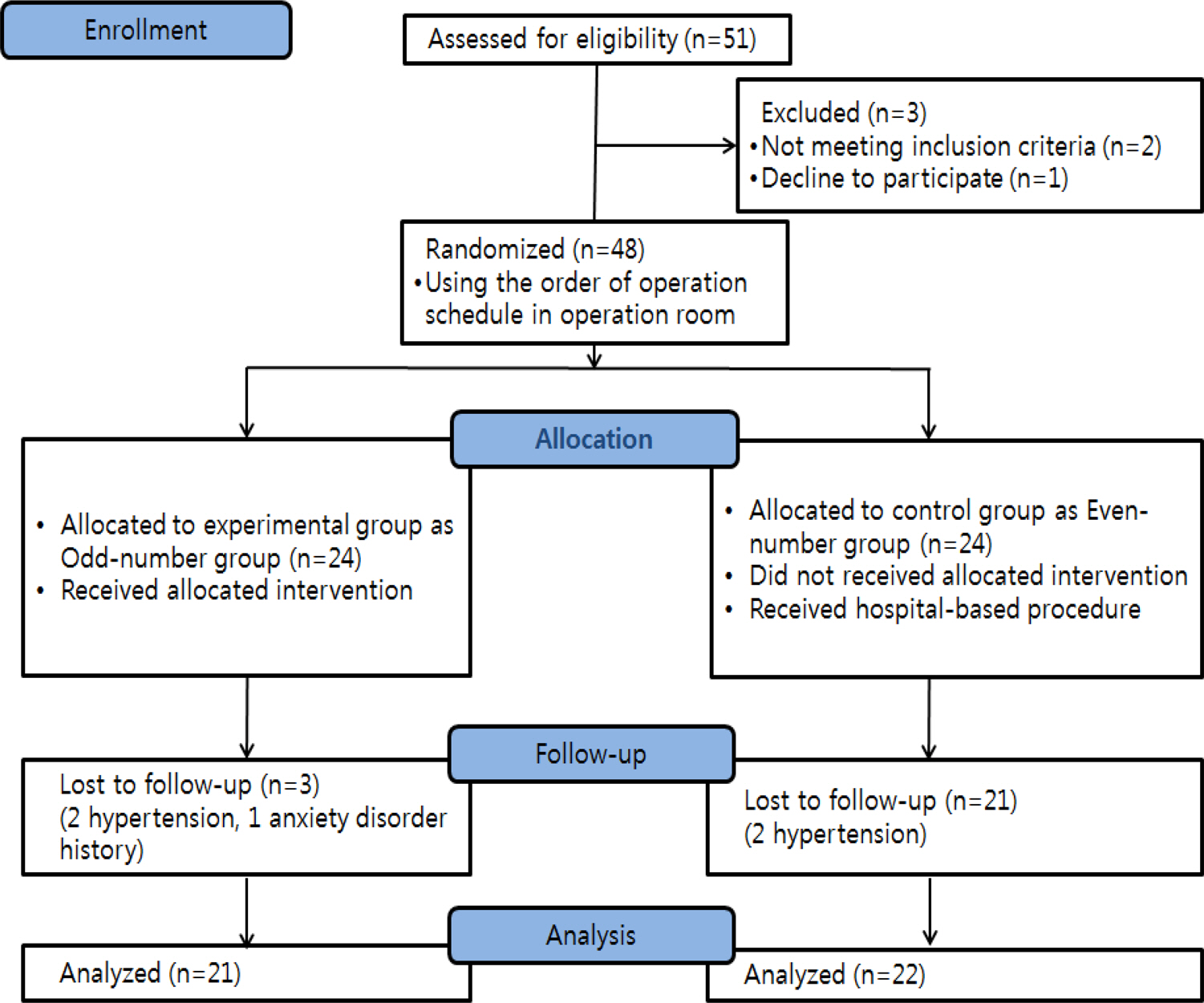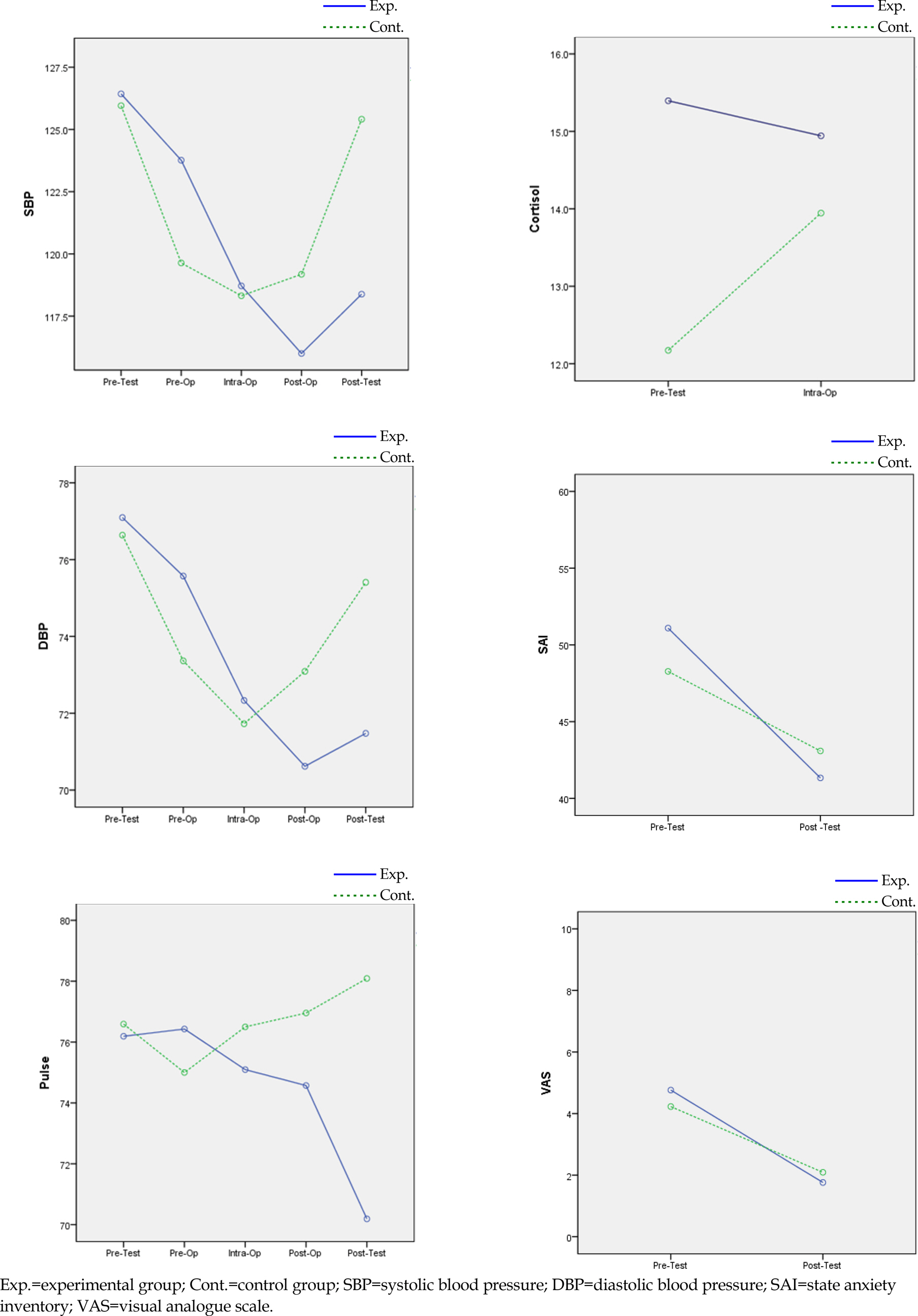Korean J Adult Nurs.
2018 Apr;30(2):194-205. 10.7475/kjan.2018.30.2.194.
The Effect of Visual Information Blocking Nursing Intervention on Stress and Anxiety during Chemoport Insertion in Adult Cancer Patients of Operation Rooms
- Affiliations
-
- 1National Health Insurance Service, Wonju, Korea.
- 2College of Nursing · The Research Institute of Nursing Science, Kyungpook National University, Daegu, Korea. wanjupark@knu.ac.kr
- KMID: 2411822
- DOI: http://doi.org/10.7475/kjan.2018.30.2.194
Abstract
- PURPOSE
The purpose of this study was to test the effect of visual information blocking nursing intervention (VIBNI) on stress and anxiety of patients undergo chemoport insertion in operating rooms.
METHODS
A non-equivalent control quasi-experimental design was used. Forth eight participants were enrolled and randomized to experimental group (VIBNI group, n=24) and control group (n=24). All participants received chemoport insertion under local anesthesia. During chemoport insertion, participants allocated to the VIBNI group had their both eyes covered with gamma-sterilized white gauze (5cm × 20cm, 0.5cm in thickness and 4g in weight) that can transmit light of 330Lux. Data from 43 participants were analysed after excluding 5 participants who withdrew (3 in the VIBNI group, and 2 in the control group) due to hypertension and anxiety history. Blood pressure and pulse were measured for stress. Blood sample (3 mL) was obtained before and during the procedure to measure serum cortisol level. State anxiety and VAS was measured for anxiety.
RESULTS
The difference of cortisol level between two groups was statistically significant after VIBNI intervention (p=.007). In terms of systolic blood pressure (p=.005) and pulse (p < .001), interaction of two groups appeared to be significant over time.
CONCLUSION
In our sample, participants received the VIBNI reported lower stress responses (cortisol level, systolic blood pressure and pulse) during chemoport insertion. Based upon our preliminary results, further evaluation in a larger sample and objective anxiety is warranted.
MeSH Terms
Figure
Reference
-
1. Yabro CH, Frogge MH, Goodman M, Groenwald SL. Cancer nursing: principles and practice. 5th ed.Sudbury, MA: Jones and Bartlett Publishers;2000.2. Kim MY. Transition of symptoms and quality of life in cancer patients on chemotherapy. Journal of Korean Academy Nursing. 2009; 39(3):433–45. https://doi.org/10.4040/jkan.2009.39.3.433.
Article3. Luciani A, Clement O, Halimi P, Goudot D, Portier F, Bassot V, et al. Catheter-related upper extremity deep venous thrombosis in cancer patients: a prospective study based on Doppler US. Radiology. 2001; 220(3):655–60. https://doi.org/10.1148/radiol.2203001181.
Article4. Kain ZN, Sevarino F, Pincus S, Alexander GM, Wang SM, Ayoub C, et al. Attenuation of the preoperative stress response with Midazolam: effects on postoperative outcomes. Anesthesiology. 2000; 93(1):141–7.5. Lee NY. The effects of informational intervention on postoperative pain following adenoidectomy in children. [master's thesis]. Busan: Pusan National University;2001. p. 1–54.6. Yoon SJ. Kim TS, Chae JH. Understanding stress by neuro-science. Journal of the Korean Academy of Family Medicine. 2005; 26(8):439–50.7. Rice VH. Handbook of stress, coping, and health: implications for nursing research, theory, and practice. 2nd ed.London: SAGE Publications;2012. p. 588.8. Lee KJ, You SJ, Lee SW, Kim SYJ, Kim YH, Won JS, et al. Introduction to psychiatric nursing. Paju: Soomoonsa;2011. p. 534.9. Fox SI. Human physiology. 14th ed.New York: McGraw-Hill Education;2015. p. 118.10. Ryu SG, Han CW. Neurobiology of anxiety. Korean Journal of Biological Psychiatry. 2001; 8(1):71–8.11. Kim YA, Sung MH. Effect of aroma hand massage on anxiety and immune function in patients with gynecology surgery under local anesthesia. Korean Journal of Women Health Nursing. 2014; 20(2):126–36. https://doi.org/10.4069/kjwhn.2014.20.2.126.
Article12. Kim GR, Oh SE. The effects of foot massage on anxiety and sleep satisfaction response in preoperative patients undergoing abdominal surgery. Journal of Korean Academic Society of Home Health Care Nursing. 2009; 16(2):108–14.13. Jeong GS, Kang YH. The effects of music therapy on anxiety, sedation, and stress responses of patients undergoing surgery with spinal anesthesia. Korean Journal of Adult Nursing. 2016; 28(5):525–35. https://doi.org/10.7475/kjan.2016.28.5.525.
Article14. Choi MS, Lee EJ. Effects of noise block on anxiety and vital sign of patients with gynecologic laparoscopic surgery in operating room. Korean Journal of Occupational Health Nursing. 2012; 21(3):317–25. https://doi.org/10.5807/kjohn.2012.21.3.317.
Article15. Cho MJ, Hong MS. A study on the effect of supportive nursing care to anxiety reduction of the patient immediately before surgery in the operating room. Korean Journal of Adult Nursing. 2001; 13(4):632–40.16. Moon HS, Lee HY, Lee JA. The effects of relaxation therapy on pain and anxiety in spinal anesthesia surgery patients. Journal of East-West Nursing Research. 2009; 15(1):54–62.17. Hur YR. The effect of distraction using video glasses on anxiety of surgery patients under local anesthesia. [master's thesis]. Daejeon: Eulji University;2015. p. 1–64.18. Kerimoglu B, Neuman A, Paul J, Stefanov DG, Twersky R. Anesthesia induction using video glasses as a distraction tool for the management of preoperative anxiety in children. Anesthesia & Analgesia. 2013; 117(6):1373–9. https://doi.org/10.1213/ANE.0b013e3182a8c18f.
Article19. Morris LD, Louw QA, Grimmer-Somers K. The effectiveness of virtual reality on reducing pain and anxiety in burn injury patients: a systematic review. The Clinical Journal of Pain. 2009; 25(9):815–26. https://doi.org/10.1097/ajp.0b013e3181aaa909.20. Mitchell M. Conscious surgery: influence of the environment on patient anxiety. Journal of Advanced Nursing. 2008; 64(3):261–71. https://doi.org/10.1111/j.1365-2648.2008.04769.x.
Article21. Kim MJ, Lee EN. Development of an instrument to measure intraoperative caring behaviors perceived by regional anesthesia patients. Journal of Korean Academy of Nursing. 2012; 42(5):749–58.
Article22. An OH, Hao J, Jo YM. A study of standard illuminance comparison between China and South Korea. Paper presented at: Proceedings of KIIEE Annual Conference. 2010. September 29; Seoul.23. Lee JS, Lee HW. A study on influence of the stress in a color temperature and controllable illuminance environment on human body. Journal of Korea Society of Color Studies. 2015; 29(2):125–34. https://doi.org/10.17289/jkscs.29.2.201505.125.24. Park JY, Lee HW, Choi KH, Lee JS. A study on psychological reaction and visibility consequent on illuminance and color temperature. Journal of Korea Society of Color Studies. 2017; 31(2):129–36.25. Telecommunication Technology Association. IT terminology dictionary [Internet]. Seoul: Telecommunication Technology Association;2017. [cited 2017 May 10]. Available from: . https://terms.tta.or.kr/dictionary/dictionaryView.do?word_seq=059769-1.26. Han DW, Lee JH, Jeon GG. Korean adaptation of Spielberger's STAI (K-STAI). Korean Journal of Health Psychology. 1996; 1(1):1–14.27. Cline ME, Herman J, Shaw ER, Morton RD. Standardization of the visual analogue scale. Nursing Research. 1992; 41(6):378–9. https://doi.org/10.1097/00006199-199211000-00013.
Article28. Ju MJ. A study on the effect of OR nurse's information on the preoperative anxiety of the gastrectomy patients. [master's thesis]. Seoul: Ewha Womans University;2002. p. 1–65.29. Lee SY, Lim JA, Woo NS, Lee YC, Choi YS, Park HJ, et al. The effects of music on maternal anxiety and the evaluation of ex-plicit and implicit memory during cesarean section. Korean Journal of Anesthesiology. 2004; 47(3):341–6. https://doi.org/10.4097/kjae.2004.47.3.341.
Article
- Full Text Links
- Actions
-
Cited
- CITED
-
- Close
- Share
- Similar articles
-
- Chemoport Insertion using Cephalic Vein
- The Effect of Informational Intervention Delivered by Electronic Patient Information Board in The Waiting Room on The Anxiety of Mothers Whose Children Underwent Elective Surgery
- Depression, Stress, Anxiety and Mindfulness in Nursing Students
- The Effect of Laughter Therapy on Depression, Anxiety, and Stress in Patients with Breast Cancer Undergoing Radiotherapy
- The Effect of Preoperative Teaching on the Emotional Status of Patients Prior to Surgery



